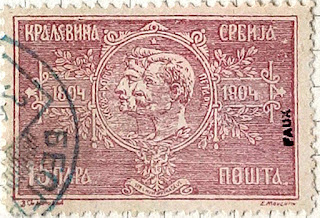The Coronation Issue of 1904
A special set of stamps commemorating the crowning of King Peter and the first Serbian uprising under Kara George, was issued the day of the coronation, September 8 1904.
The stamps were designed by Djoka Jovanovich of Belgrade.
The engraving was done by E. Mouchon in Paris where the cliches were also prepared.
All the stamps have the name, "Dj. Jovanovich in Cyrillic in the lower left corner and E. Mouchon in Latin letters in the lower right.
It was printed at the new Stamp Printing Works of the State Monopoly by typography.
They are line perforated 11.5
Used, these stamps are much rarer than unused, and many forged cancellations are being circulated.
Genuine covers are not common, since the stamps were in use a little over three months, September 8th to December 31, 1904.
After demonetization, sets of these stamps were sold at a reduced rate at the Belgrade post office from April 1908 to August 1911. The remainders were sold at auction in January 1911.
Quantities printed
1,950,300 copies of the 5 para
1,962,800 copies of the 10 para
491,000 copies of the 15 para
493,600 copies of the 25 para
489,500 copies of the 50 para
196,400 copies of the I dinar
98,850 copies of the 3 dinar
99,100 copies of the 5 dinar
This stamp is often portrayed as having the shape of a death mask when viewed in a certain direction.
Contemporary philatelists noticed that when the stamps with portraits are turned upside down a ghostly face may be seen in the space where the two heads overlap.
Many stamp collectors believe this is the death mask of Aleksandar I Obrenović, the assassinated king.
The coincidence has been attributed to macabre humor of Mr. Jovanović.
The engraver Mouchon has stated this was not his intent.
Genuine stamps
There are varieties such as gutter pairs, proofs and full imperforate complete sets and partial imperforates in the 5, 10 & 15 values
 |
| Imperforate top |
Forgeries
There are 3 forgery types all sold by Fournier with one attributed to Smeets.
 |
| Original |
This is a relatively common forgery and almost certainly not his work.
1. The distinct feature is the top of the P with a straight lower horizontal line instead of sloping as in the original - Key feature
2. There are breaks in the faces and coarse lines background throughout
3. The names are blurred
4. The bottom banner words are not clear
5, The right leg of the letter that looks like an H is shorter and the last 2 letters are shorter than the first ones
The same stamps were also offered perfed with a typical Fournier Serbia cancel
Very common forgery
Overall the design is accurate and the most dangerous of the forgeries.
The 'N' and 'J' of the word CPbNJA overlap each other slightly - this is the key feature
Lucian Smeets was a stamp forger from Brussels Belgium around 1910.
There is a record of Smeets being part of a group of forgers in Brussels consisting of Vanderberghe, Smets (Smeets) and Delsiune.
His forte was bleaching out parts of stamps and reprinting them or adding details.
The stamp dealer Louis Pasche from Lausanne also offered these Smeets forgeries in 1928 in a pricelist he send to several clients.
He offers 10 sets of all values for 50 Swiss Francs and 100 set for 400 Swiss Francs.
This gives one some idea of the number of these stamps on the market
3rd forgery - source unknown, may be a later printing of the first forgery
The overall stamp is very rough
I have only seen it as an imperf
Colors appear darker
The 2nd letter "P" has a rounded top as in the "Fournier" forgery
The last 3 letters of the 2nd word are all the same height unlike the first forgery shown.
Overall very rough forgery with heavy background lines
Fournier Collection
The Geneva collection with blocks taken from 4X4 sheets











No comments:
Post a Comment
THANK YOU for the feedback. Your comment will be reviewed and appear on this blog within 24 hours
Do you have any pic to share? Use this code [img]your-image-url-here[/img]